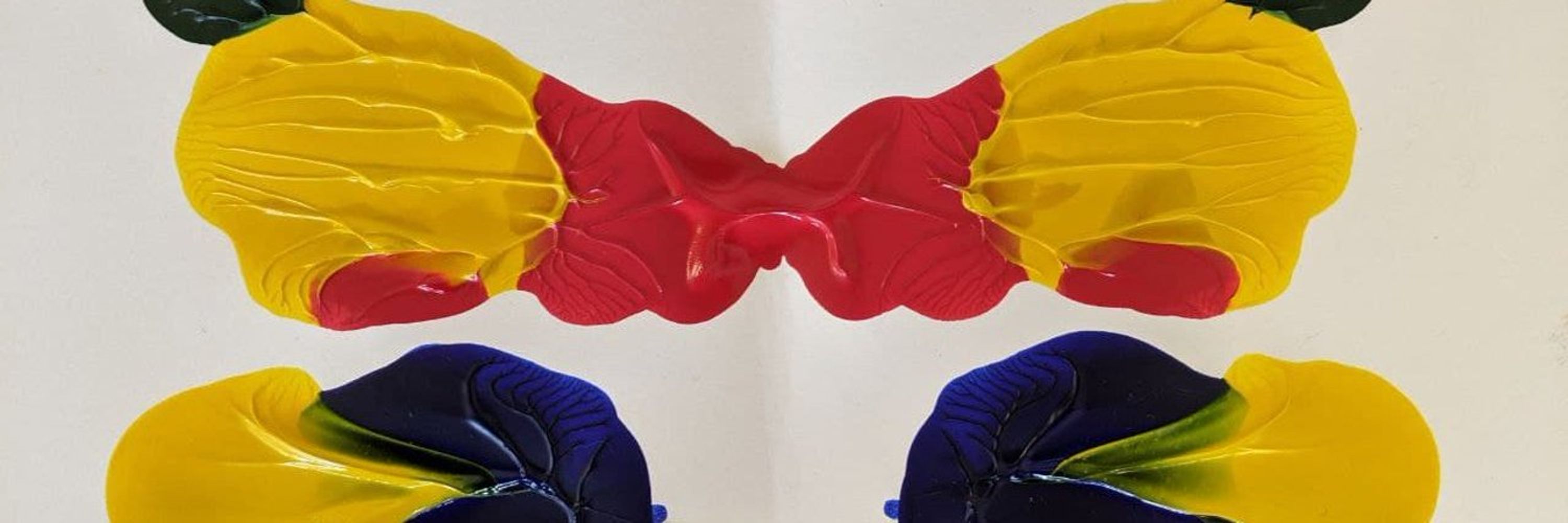
Matan Mazor
@matanmazor.bsky.social
Post-doctoral research fellow in cognitive neuroscience (Oxford), interested in complex systems and in simple systems who believe they are complex systems
מביך בשביל האוניברסיטה. טוב לדעת שלפחות הרקטור, מונא מארון, תומכת במכתב (מתוך נאום שלה בטקס בוגרי תואר בחינוך)
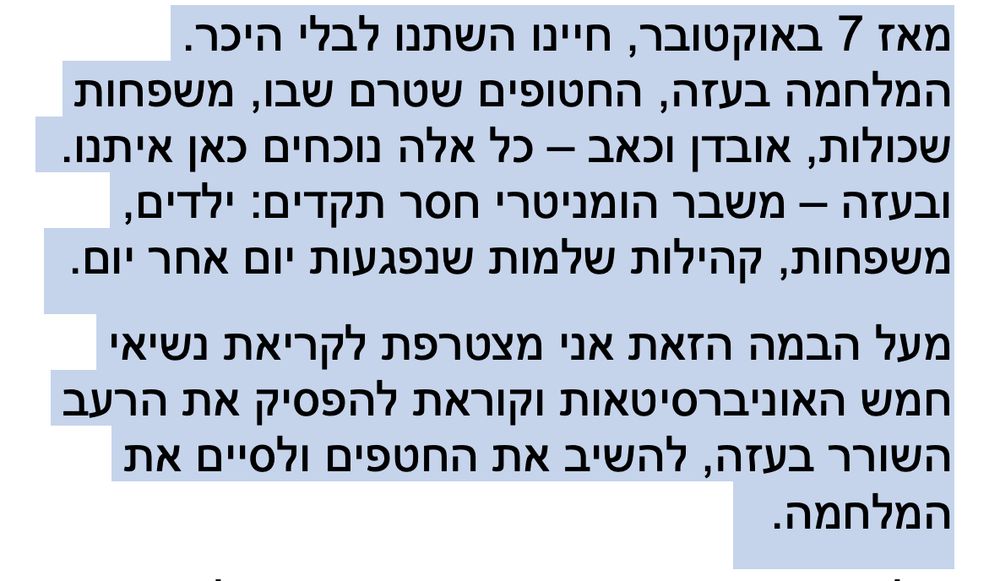
July 30, 2025 at 1:03 PM
מביך בשביל האוניברסיטה. טוב לדעת שלפחות הרקטור, מונא מארון, תומכת במכתב (מתוך נאום שלה בטקס בוגרי תואר בחינוך)
See the full 6 pages for perceptual and meta-perceptual learning effects, prospective confidence, and one very honest closing paragraph:
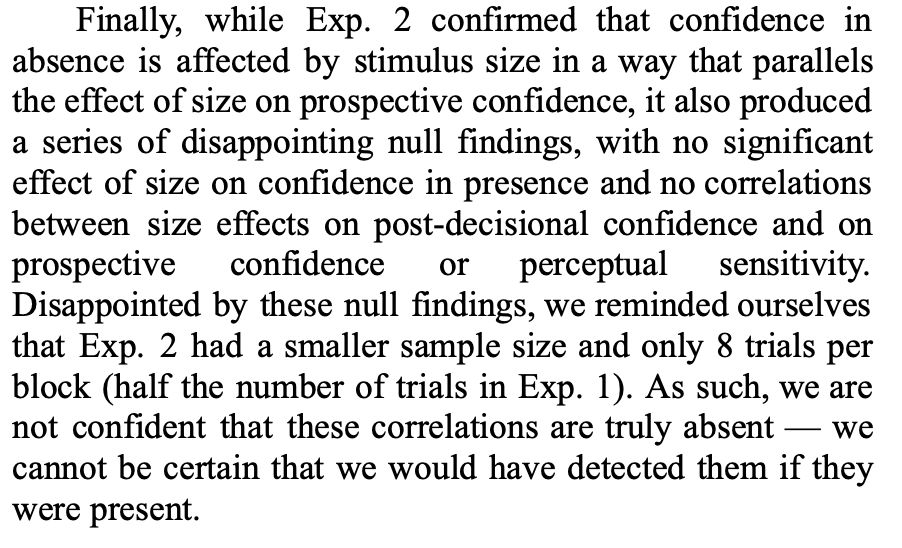
July 23, 2025 at 3:39 AM
See the full 6 pages for perceptual and meta-perceptual learning effects, prospective confidence, and one very honest closing paragraph:
Despite not being fitted to confidence ratings, model parameters correlated with confidence across subjects. Specifically, a "true visibility" parameter, derived from decisions and RTs, predicted confidence in presence, and a "believed visibility" parameter predicted confidence in absence.

July 23, 2025 at 3:34 AM
Despite not being fitted to confidence ratings, model parameters correlated with confidence across subjects. Specifically, a "true visibility" parameter, derived from decisions and RTs, predicted confidence in presence, and a "believed visibility" parameter predicted confidence in absence.
We also fitted our ideal-observer model from psycnet.apa.org/fulltext/202..., in which agents observe noisy sensor activations and decide between PRESENT, ABSENT, or WAIT, as a function of their impatience and, crucially, their beliefs about the expected visibility of stimuli.

July 23, 2025 at 3:30 AM
We also fitted our ideal-observer model from psycnet.apa.org/fulltext/202..., in which agents observe noisy sensor activations and decide between PRESENT, ABSENT, or WAIT, as a function of their impatience and, crucially, their beliefs about the expected visibility of stimuli.
The beautiful thing is that confidence in presence tracked true visibility (higher for smaller stimuli), but confidence in absence tracked believed visibility (higher for bigger stimuli). Only the effect of size on confidence in presence correlated with its effect on objective sensitivity.

July 23, 2025 at 3:29 AM
The beautiful thing is that confidence in presence tracked true visibility (higher for smaller stimuli), but confidence in absence tracked believed visibility (higher for bigger stimuli). Only the effect of size on confidence in presence correlated with its effect on objective sensitivity.
Maya and I used a meta-perceptual illusion to obtain a clear behavioural dissociation. In our task, targets were more visible when the display was small, but participants systematically believed that bigger stimuli made targets easier to see.

July 23, 2025 at 3:27 AM
Maya and I used a meta-perceptual illusion to obtain a clear behavioural dissociation. In our task, targets were more visible when the display was small, but participants systematically believed that bigger stimuli made targets easier to see.
Confidence in absence as confidence in counterfactual visibility: a CogSci proceedings paper with star MSc student Maya Schipper, is now out on PsyArXiv:
osf.io/preprints/ps...
🧵👇
osf.io/preprints/ps...
🧵👇
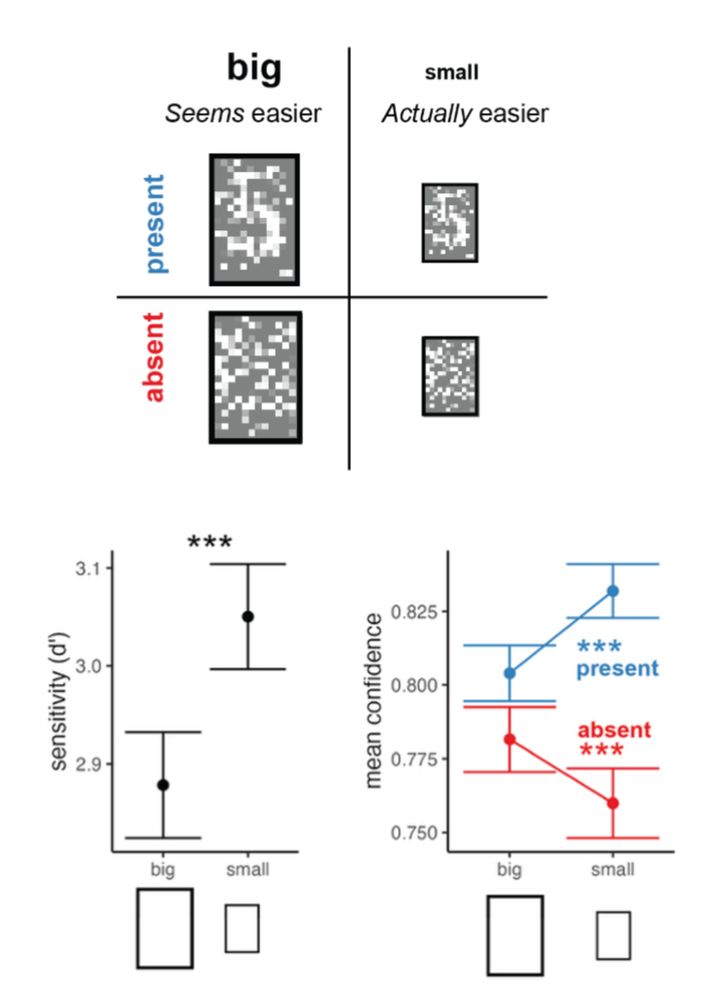
July 23, 2025 at 3:23 AM
Confidence in absence as confidence in counterfactual visibility: a CogSci proceedings paper with star MSc student Maya Schipper, is now out on PsyArXiv:
osf.io/preprints/ps...
🧵👇
osf.io/preprints/ps...
🧵👇
The paper also features fun things like reverse correlation, backwards induction, TAYLOR SWIFT, a new non-parametric sign-consistency test @itayyaron.bsky.social, and some evidence that the Bayesian p(correct) is not a bad approximation of subjective confidence in this task.
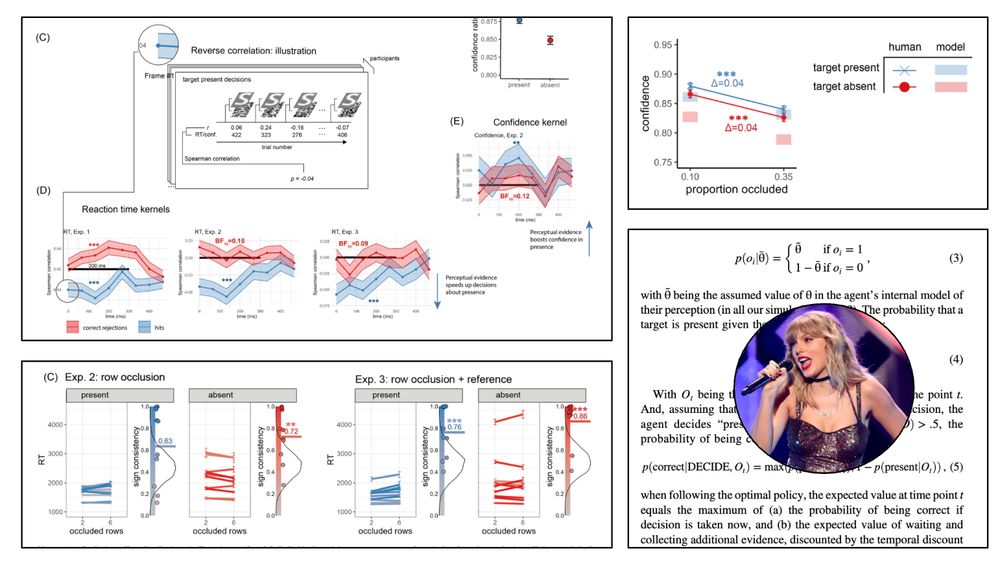
March 21, 2025 at 4:59 PM
The paper also features fun things like reverse correlation, backwards induction, TAYLOR SWIFT, a new non-parametric sign-consistency test @itayyaron.bsky.social, and some evidence that the Bayesian p(correct) is not a bad approximation of subjective confidence in this task.
Third, we demonstrate this principle with partial occlusion. The more we occluded the display, people missed more targets. But occlusion also made *some* people more likely to make “present” responses on target-absent trials: a reflection of their belief that they may have been missing the target.
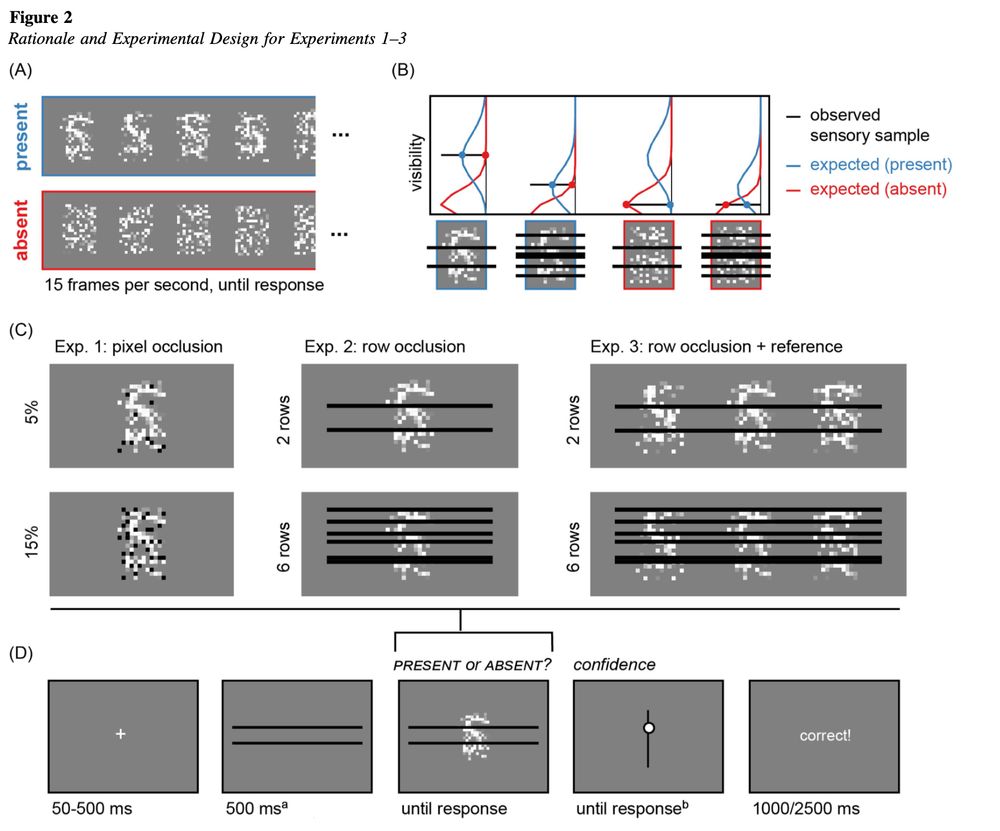
March 21, 2025 at 4:59 PM
Third, we demonstrate this principle with partial occlusion. The more we occluded the display, people missed more targets. But occlusion also made *some* people more likely to make “present” responses on target-absent trials: a reflection of their belief that they may have been missing the target.
Second, we show that a model parameter that controls the rate of perceptual evidence affects decisions when a target is present, but it is a parameter that controls *meta-perceptual beliefs about the rate of perceptual evidence* that controls decisions when a target is absent.

March 21, 2025 at 4:59 PM
Second, we show that a model parameter that controls the rate of perceptual evidence affects decisions when a target is present, but it is a parameter that controls *meta-perceptual beliefs about the rate of perceptual evidence* that controls decisions when a target is absent.
First, we propose a new model of perceptual detection as a series of momentary decisions between 3 actions: decide present / absent, or accumulate more evidence. The perceptual evidence that goes into this process is noisy, but the decisions are optimal for maximising discounted long-term reward.

March 21, 2025 at 4:59 PM
First, we propose a new model of perceptual detection as a series of momentary decisions between 3 actions: decide present / absent, or accumulate more evidence. The perceptual evidence that goes into this process is noisy, but the decisions are optimal for maximising discounted long-term reward.
Our "I would have seen it if it were there" paper — a collaboration with @ranimo.bsky.social and @clarepress.bsky.social — is now out in Psych. Review.
There’s a lot in this paper, but here are what I see as the 3 main takeaways:
psycnet.apa.org/fulltext/202...
There’s a lot in this paper, but here are what I see as the 3 main takeaways:
psycnet.apa.org/fulltext/202...
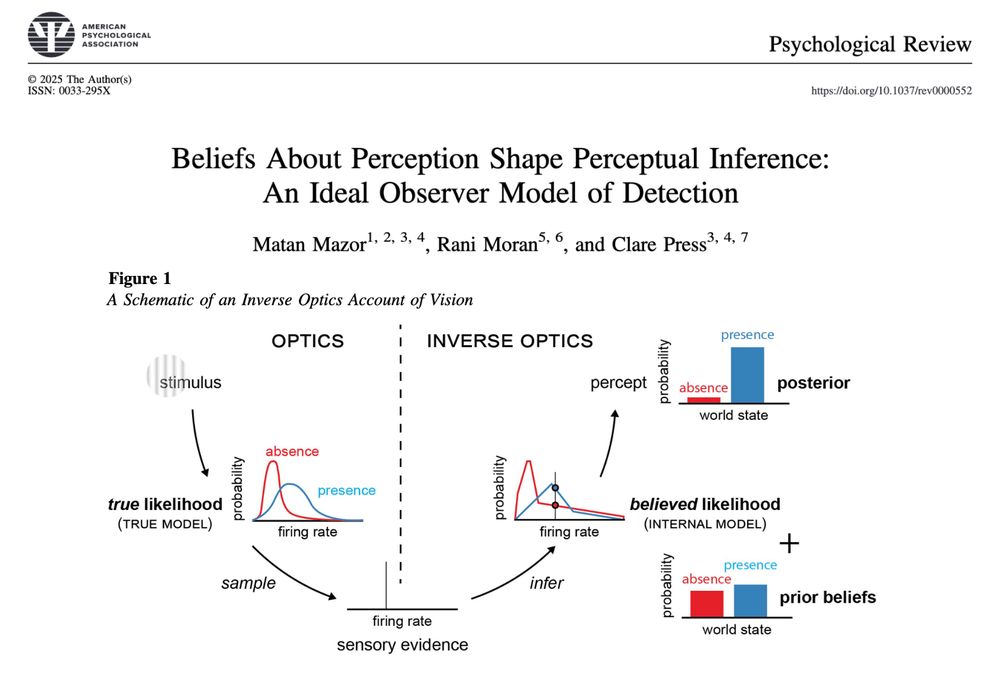
March 21, 2025 at 4:48 PM
Our "I would have seen it if it were there" paper — a collaboration with @ranimo.bsky.social and @clarepress.bsky.social — is now out in Psych. Review.
There’s a lot in this paper, but here are what I see as the 3 main takeaways:
psycnet.apa.org/fulltext/202...
There’s a lot in this paper, but here are what I see as the 3 main takeaways:
psycnet.apa.org/fulltext/202...
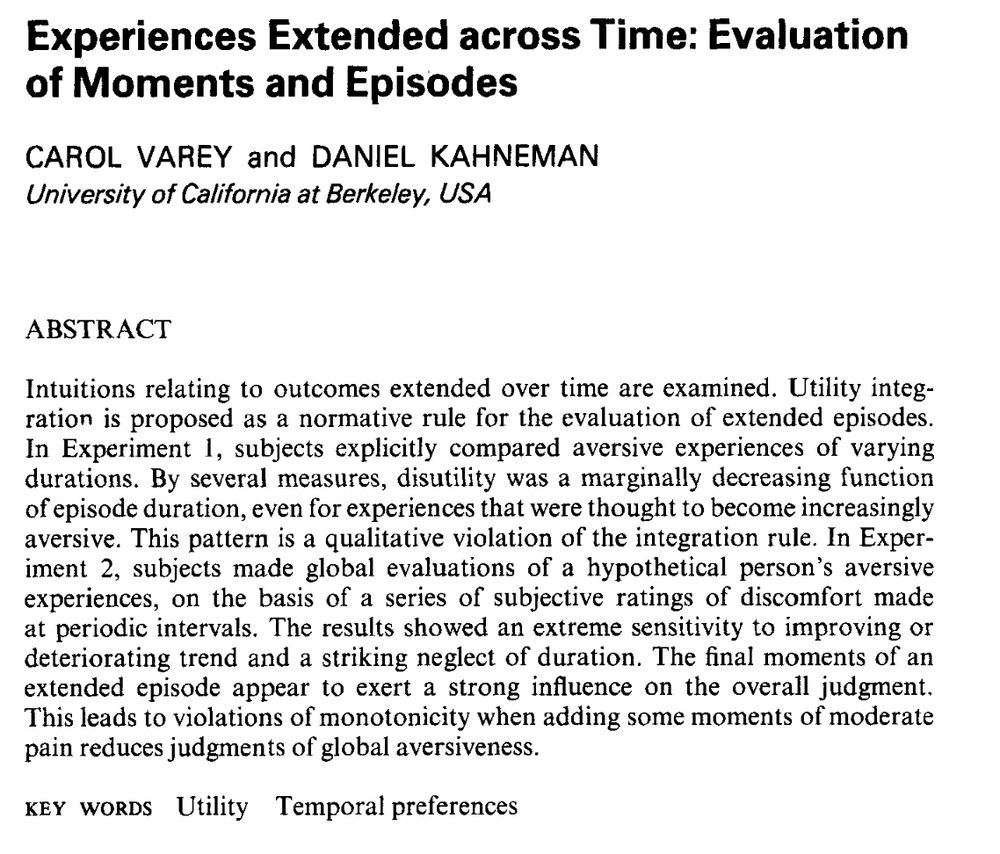
March 15, 2025 at 2:34 PM
Revising an ethics application, and making sure not to make the participants that I am experimenting upon feel like they are being 'experimented upon'

March 14, 2025 at 10:43 AM
Revising an ethics application, and making sure not to make the participants that I am experimenting upon feel like they are being 'experimented upon'
From June Huh's Fields Medal interview

November 20, 2024 at 8:32 AM
From June Huh's Fields Medal interview
George Ainslie on clarity in scientific writing

November 3, 2024 at 1:41 PM
George Ainslie on clarity in scientific writing
10/11 subject-level model-fitting revealed a beautiful dissociation: while occlusion effects on accuracy and reaction times in target-present trials were a function of visibility, the same effects in target-absent trials were driven by beliefs about visibility.

June 25, 2024 at 1:37 PM
10/11 subject-level model-fitting revealed a beautiful dissociation: while occlusion effects on accuracy and reaction times in target-present trials were a function of visibility, the same effects in target-absent trials were driven by beliefs about visibility.
@ItayYaron @Liad_Mudrik @n_faivre 10/11 subject-level model-fitting revealed a beautiful dissociation: while occlusion effects on accuracy and reaction times in target-present trials were a function of visibility, the same effects in target-absent trials were driven by beliefs about...

June 25, 2024 at 1:36 PM
@ItayYaron @Liad_Mudrik @n_faivre 10/11 subject-level model-fitting revealed a beautiful dissociation: while occlusion effects on accuracy and reaction times in target-present trials were a function of visibility, the same effects in target-absent trials were driven by beliefs about...
9/11 (to show that this was true variation and not just noise we used the sign-consistency R package that superstar Itay Yaron developed, together with @liadmudrik.bsky.social , @nfaivre.bsky.social and myself: github.com/mufcItay/sig...). Read more here: osf.io/preprints/psyarxiv/ebg8w

June 25, 2024 at 1:35 PM
9/11 (to show that this was true variation and not just noise we used the sign-consistency R package that superstar Itay Yaron developed, together with @liadmudrik.bsky.social , @nfaivre.bsky.social and myself: github.com/mufcItay/sig...). Read more here: osf.io/preprints/psyarxiv/ebg8w
9/11 (to show that this was true variation and not just noise we used the sign-consistency R package that superstar @ItayYaron developed, together with @Liad_Mudrik, @n_faivre and myself: https://github.com/mufcItay/signcon). Read more here: <a href="http://osf.io/preprints/psyarxiv/ebg8w" class="hover:underline text-blue-600 dark:text-sky-400 no-card-link" target="_blank" rel="noopener" data-link="bsky">http://osf.io/preprints/psyarxiv/ebg8w

June 25, 2024 at 1:34 PM
9/11 (to show that this was true variation and not just noise we used the sign-consistency R package that superstar @ItayYaron developed, together with @Liad_Mudrik, @n_faivre and myself: https://github.com/mufcItay/signcon). Read more here: <a href="http://osf.io/preprints/psyarxiv/ebg8w" class="hover:underline text-blue-600 dark:text-sky-400 no-card-link" target="_blank" rel="noopener" data-link="bsky">http://osf.io/preprints/psyarxiv/ebg8w
7/11 so if decisions in target-absent trials are sensitive to occlusion, this is due to something other than visibility itself. According to our model, this something is beliefs about visibility.

June 25, 2024 at 1:29 PM
7/11 so if decisions in target-absent trials are sensitive to occlusion, this is due to something other than visibility itself. According to our model, this something is beliefs about visibility.
7/11 so if decisions in target-absent trials are sensitive to occlusion, this is due to something other than visibility itself. According to our model, this something is beliefs about visibility.

June 25, 2024 at 1:28 PM
7/11 so if decisions in target-absent trials are sensitive to occlusion, this is due to something other than visibility itself. According to our model, this something is beliefs about visibility.
6/11 To isolate the role of beliefs about visibility, we occluded parts of the display in a detection task. Our idea was the following: occlusion affects the visibility of present stimuli, but it can’t affect the visibility of absent stimuli.

June 25, 2024 at 1:26 PM
6/11 To isolate the role of beliefs about visibility, we occluded parts of the display in a detection task. Our idea was the following: occlusion affects the visibility of present stimuli, but it can’t affect the visibility of absent stimuli.


